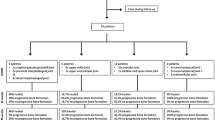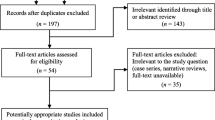Summary
Extracorporeal shock waves have revolutionized urological stone treatment. Nowadays shock waves are widely used in orthopedics, too. This article reviews the applications of extracorporeal shock waves on bone and adjacent soft tissue. The osteoneogenetic effect of extracorporeal shock waves has been proven and can be used to treat pseudarthrosis with a success rate of around 75 %. Shock waves have a positive effect in tennis and golfer's elbow, calcaneal spur, and the complex called “periarthritis humeroscapularis.” The mechanism for this is not yet known, and results from large prospective and randomized studies are still lacking. However, the treatment has been performed many thousands of times. In patients in whom conservative treatment has failed surgery used to be the only choice, but its success rate barely exceeds that of shock wave therapy and surgery can still be done if shock wave therapy fails. Extracorporeal shock waves will have an impact on orthopedics comparable to its effect in urology. Scientific evaluations, professional certifications, quality assurance and reimbursement issues present great challenges.
Zusammenfassung
Extrakorporale Stoßwellen haben die urologische Steintherapie revolutioniert. In jüngster Zeit haben sie auch breiten Eingang in den Bereich der Orthopädie gefunden. Der vorliegende Artikel gibt eine Übersicht über Anwendungen von extrakorporalen Stoßwellen (ESW) am Knochen und knochennahen Weichgeweben. Der osteoneogenetische Effekt von ESW ist gesichert und kann in der Therapie von Pseudarthrosen mit einer Erfolgsrate um 75 % eingesetzt werden. Ferner zeigen Stoßwellen einen positiven Einfluß bei Tennis- und Golferellbogen, Fersensporn und dem Symptomenkomplex „Periarthritis humeroscapularis“. Der Wirkmechanismus ist unbekannt, große prospektive randomisierte Studien fehlen. Dennoch wird das Verfahren bereits vieltausendfach angewandt. Dies liegt auch daran, daß bei konservativ austherapierten Patienten nur eine operative Therapie in Frage kommt, die in der Regel in ihrer Erfolgsrate die Stoßwellentherapie nicht eindeutig übertrifft, und die im Falle eines Mißerfolgs der Stoßwellentherapie problemlos durchgeführt werden könnte. Die Nutzung von ESW in der Orthopädie wird eine ähnlich große Rolle spielen wie in der Urologie. Die wissenschaftlichen Grundlagen, Fachkundenachweise, Qualitätssicherung und Abrechnungsmodalitäten sind dabei noch große Herausforderungen.
Similar content being viewed by others
Author information
Authors and Affiliations
Rights and permissions
About this article
Cite this article
Haupt, G. Shock wave treatment in orthopedics. Urologe [A] 36, 233–238 (1997). https://doi.org/10.1007/s001200050096
Issue Date:
DOI: https://doi.org/10.1007/s001200050096




